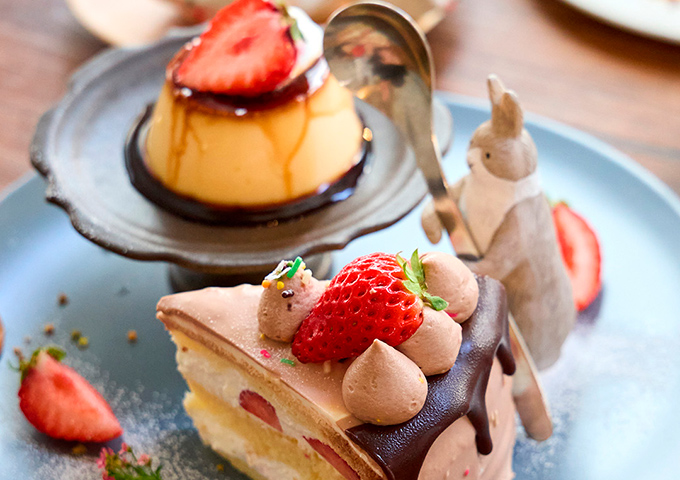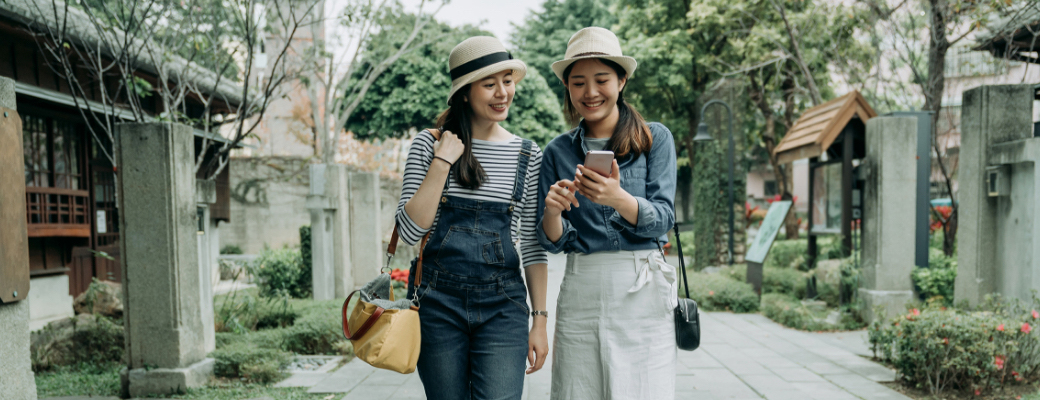
Food and Drinks
Take a relaxing break with cute sweets along the Nankai Line.

Make the most of Japan’s spring!
The unique Japanese culture of enjoying a drinking party while taking in the cherry blossoms
From about the middle of March, news reports in each region of Japan announce the start of the local cherry blossom season by letting viewers know that the blossoms have opened. It's an indication of just how much everybody looks forward to this season. It is not only the fully open cherry blossoms that are admired but also the elegance of the scattered petals on the water's surface or the ground.
This activity of appreciating the various forms of the flowers is known as "cherry blossom viewing". Cherry blossom viewing began with the nobility about 1200 years ago, and later grew in popularity among the samurai and common people. It involves not just looking at the blossoms but often also enjoying a cup of sake rice wine and a boxed lunch. The famous warrior commander Hideyoshi Toyotomi is recorded as having gathered together as many as 1300 people in 1598 and held a lavish cherry blossom viewing party. Today, as in the past, cherry blossom viewing is one of the big events of spring.
*Novel coronavirus measures
Due to novel coronavirus measures, some facilities may be temporarily closed on very short notice. Please also note that some parks may ask that you refrain from holding parties with a large group of people.
Recommended for couples and families!
Castle and cherry blossoms A locale with characteristically Japanese scenery
Wakayama Castle, which is located in the middle of Wakayama City, is a popular sightseeing spot with a garden, history museum and zoo. There are cherry trees dotted throughout the garden, but the highlight is the spectacular line of cherry trees that extends from Okaguchi Gate to Ninomaru Park. There is also a vantage point set up at Honmaru Goten where you can photograph the castle tower beyond the cherry blossoms, so you can take some impressive shots from here.
Night-time cherry blossom viewing around Wakayama Castle is also recommended. During the cherry blossom festival held every year from late March, the castle tower is lit up after sundown, with paper lanterns also casting a warm glow. It's a fantastical scene quite different from the daytime, so it's definitely worth a visit.
The Tourism Information Center inside Wakayama Castle rents out historical costumes to visitors (*reservations must be made at least 7 days in advance). You can change into a costume of your choosing, such as a feudal lord, princess, samurai, ninja or armor-wearing warrior, and stroll around the castle tower and within the castle.
Recommended for couples and friend groups!
Early blooming koshino cherry trees adorning Japan's oldest reservoir
Sayamaike is Japan's oldest dam-type reservoir, constructed in around 616. About 1,000 koshinohigan cherry trees are planted along the trail that encircles the reservoir, and there are also kanzan (a type of multi-layered cherry blossom), ukon (with large yellow-green flowers) and other varieties of cherry tree found here, with the total numbering about 1300 trees. Koshinohigan is an early flowering variety, so its best time is early in the season even in Osaka. One lap of the trail is about 2,850 meters, and many people can be seen jogging or walking beneath the cherry blossoms. This renowned photogenic spot was planned out by the international architect Tadao Ando, and its innovative design is characteristic of his work. It's a must-see for those interested in land development and buildings.
There are also numerous cherry trees planted along the tracks near Nankai Electric Railway's Osakasayamashi Station and Sayama Station, and you can enjoy the spring view from the train windows.
Recommended for couples and friend groups!
Stroll around the World Heritage Site of Mount Koya while taking in the cherry blossoms
Mount Koya is the holy ground of the Shingon School and is recognized as a World Cultural Heritage Sites for its value as a "sacred site and pilgrimage route in the Kii Mountains". There are 117 temples on Mount Koya, the most prominent of which is Kongobu-ji Temple, the head temple of the Buddhist sect here. There are cherry trees dotted all about the towns, in both the temple gardens and the approaches to the temples. Since the town is located approximately 800 meters above sea level, the trees blossom slightly later than those on the plain. Depending on the variety of tree, the blossoms may still be at their best until around the beginning of May. Many of the trees here are yamazakura, a wild variety, but someiyoshino and shidarezakura (weeping cherry trees) can also be seen here. For example, the two yaebenishidare that stand along the approach to the Kongobu-ji Temple have bright red blossoms that dazzle many visitors.
The row of cherry trees that extends along the train line from Kamuro Station to Kudoyama Station on Nankai Electric Railway's Koya Line is also a recommended viewing spot. At night, they are lit up by LED lights specifically designed so that the blossoms appear the same color as in the daytime, so you can fully enjoy the spring view from the train windows while traveling there and back.
Recommended for families!
A World Heritage Site and symbolic park adjacent to the burial mound of Emperor Nintoku
Daisen Park is an expansive park located between the burial mound of Emperor Nintoku, which is the world's largest tomb, and the burial mount of Emperor Richu. There are about 1,000 cherry trees of roughly 50 varieties planted here. Particularly recommended is the area known as the "cherry blossom promenade" located within the lawned square. Someiyoshino and several varieties of shidarezakura bloom here, and the entire surrounding area looks as if it has been dyed pink. It makes for a beautiful contrast against the green lawns, and the view seems just made for taking professional shots.
Daisen Park is also the location of Sakai City Museum, the Central Library, a Japanese garden and a teahouse, among other facilities, so it offers not just cherry blossom viewing but also several other activities. For example, the Sakai City teahouse "Shin'an" serves tea to visitors, who are seated in chairs for better comfort. Visitors do not need to be familiar with the art of tea ceremony. Anybody can casually drop in here and experience a little of the world of tea ceremony.
Recommended for families!
When spring arrives, the foothills of the mountain take on a soft pink hue.
When spring reaches Nagano Park, which is located at the base of Mount Kongo, the scenery undergoes a spectacular transformation. The someiyoshino variety grows in abundance on the slopes of the mountain, with corridors of shidarezakura blossoming in between, so that the entire mountain is wrapped in pale pink. The park, which retains its natural topography, has playground equipment where children can play, and a viewing platform for taking in an unbroken view of the mountains. It's ideal for those wanting a spring outing where they can experience nature.
The park also contains a hydrangea garden, where visitors can enjoy hydrangeas in a wide variety of colors, such as white and pale purple, from around the middle of June.
Recommended for families!
A spectacular tunnel of cherry blossoms! A comprehensive park with amusement rides
This is one of the oldest parks in Osaka, created in 1873. Its defining feature is the beautiful pine trees that are numbered among Japan's top 100 pine tree spots, but in spring it is bustling with crowds who know it as a prime location for viewing cherry blossoms. There are about 1,300 cherry trees in the park. In addition to someiyoshino, which is Japan's most typical variety, the park has varieties that bloom at different times, such as oshimazakura and multi-layered varieties. The various types of cherry blossom can therefore be enjoyed over an extended period. In particular, the pink tunnel created by the fully open cherry blossoms has a dream-like beauty.
Hamadera Park is a comprehensive park featuring a cycling road, tennis courts, a pool, rose garden and amusement rides, among other facilities. From around May and November, 6,500 rose bushes of 300 varieties create a colorful show in the rose garden. The amusement park has a ride-on steam train for children, go-karts and a children's playground, so children will find plenty to amuse them here in addition to the cherry blossoms.
Recommended for families and couples!
Enjoy a barbecue in an open area surrounded by someiyoshino cherry blossoms
Sumiyoshi Park is in a prime location about 10 minutes from Nankai Electric Railway's Namba Station. It has abundant greenery and a beautiful pond, making it a popular park for picnics. Almost all the cherry trees in Sumiyoshi Park are the someiyoshino variety. They have beautiful pale pink blossoms, and the open square surrounded by cherry trees is the perfect place for cherry blossom viewing and taking a stroll. You might see people enjoying a barbecue here as they admire the cherry blossoms.
The park is home to Japan's oldest Takatoro lighthouse, which is a unique reminder of the days when the ocean used to reach almost as far as the park.
Sumiyoshi Park is also adjacent to Sumiyoshi Taisha, one of Japan's most well-known shrines. Having been built in the year 211, Sumiyoshi Taisha boasts a long history. There are plenty of attractions here, such as the main shrine building with its four wings built in 1810 (designated a national treasure) and the Sorihashi Bridge, which at 48 degrees has the steepest incline of any bridge in Japan. This solemn and stately precinct gives visitors the opportunity to experience another side of Japanese culture.
■ Manners to follow to ensure that everyone can enjoy the cherry blossoms
Since many people will be visiting these popular cherry blossom viewing spots, we ask that visitors be mindful of others and observe public manners. Although the blossoms are inviting, please refrain from breaking off any branches or twigs. We would like everyone to enjoy the trees in their natural state. It's tempting to view the blossoms up close, but please refrain from doing so, as treading on the roots will weaken the tree. If you wish to have a party, please check in advance whether eating and drinking are permitted in your chosen spot. Please place all garbage such as empty disposable lunch boxes and cans in the bins provided. If there is no bin near you, please take your garbage home with you.
Reclining seats and cushions are handy if you want to sit and relax while gazing up at the blossoms. Spring evenings can be quite chilly in Japan. Don't forget warm clothing if you are viewing the blossoms at night. Disposable heat packs are also handy.
Code of conduct for cherry blossom viewing
- Do not break off any twigs or damage the trees in any way.
- Do not walk or sit on the roots, as this will weaken the tree.
- Check whether eating and drinking are permitted in your chosen spot.
- Do not use any flame in areas where there is a total fire ban.
- Sort your garbage into the appropriate bins. If no bins are provided, take your garbage home with you.
- Visitors drinking alcohol must not become violent toward other visitors. Do not run.

